Business Performance, HR's Role in Planning & Change Management
VerifiedAdded on 2022/11/14
|6
|1319
|402
Report
AI Summary
This report provides a comprehensive analysis of business performance, focusing on the critical role of Human Resources (HR) in strategic planning and change management. It begins by defining business performance and outlining key performance indicators (KPIs), categorizing them into financial (e.g., ROI, gross profit margin) and non-financial metrics (e.g., employee satisfaction, market share). The report then delves into the role of HR in business planning, emphasizing its importance in resource management, staff allocation, and the creation of business plans. It highlights how HR ensures the availability of a skilled workforce, manages costs, and forecasts expenses. Furthermore, the report explores HR's function in organizational change management, particularly in training, recruitment, and employee motivation. It references models like Kotter's and Bridges and Mitchell's to illustrate how HR supports employees during transitions. Finally, the report discusses the use of internal and external business data for planning purposes, including HR metrics, industry information, government regulations, and HR trends, along with the significance of employee turnover and retention data. The references included provide further context to the models and studies referenced in the report.
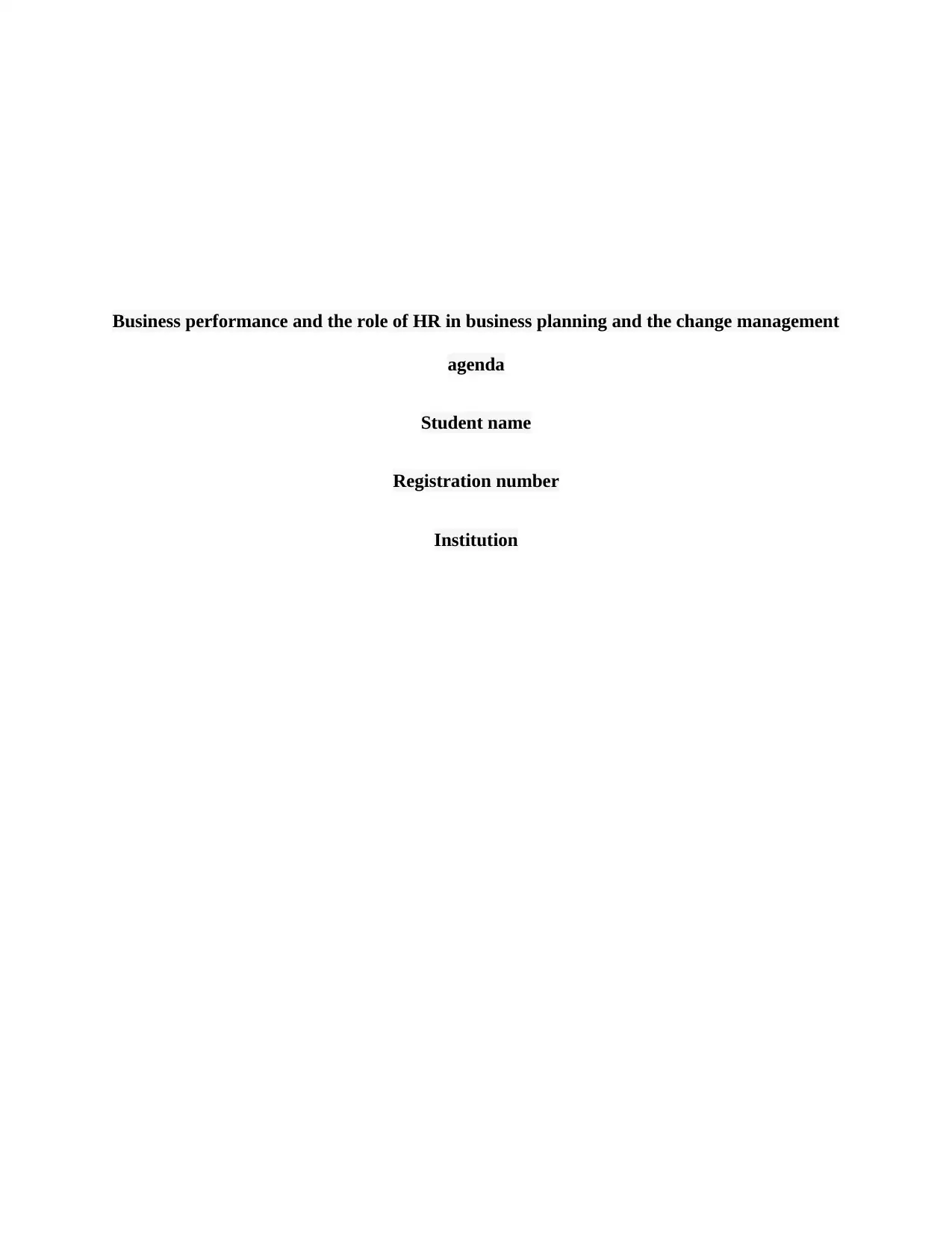
Business performance and the role of HR in business planning and the change management
agenda
Student name
Registration number
Institution
agenda
Student name
Registration number
Institution
Paraphrase This Document
Need a fresh take? Get an instant paraphrase of this document with our AI Paraphraser
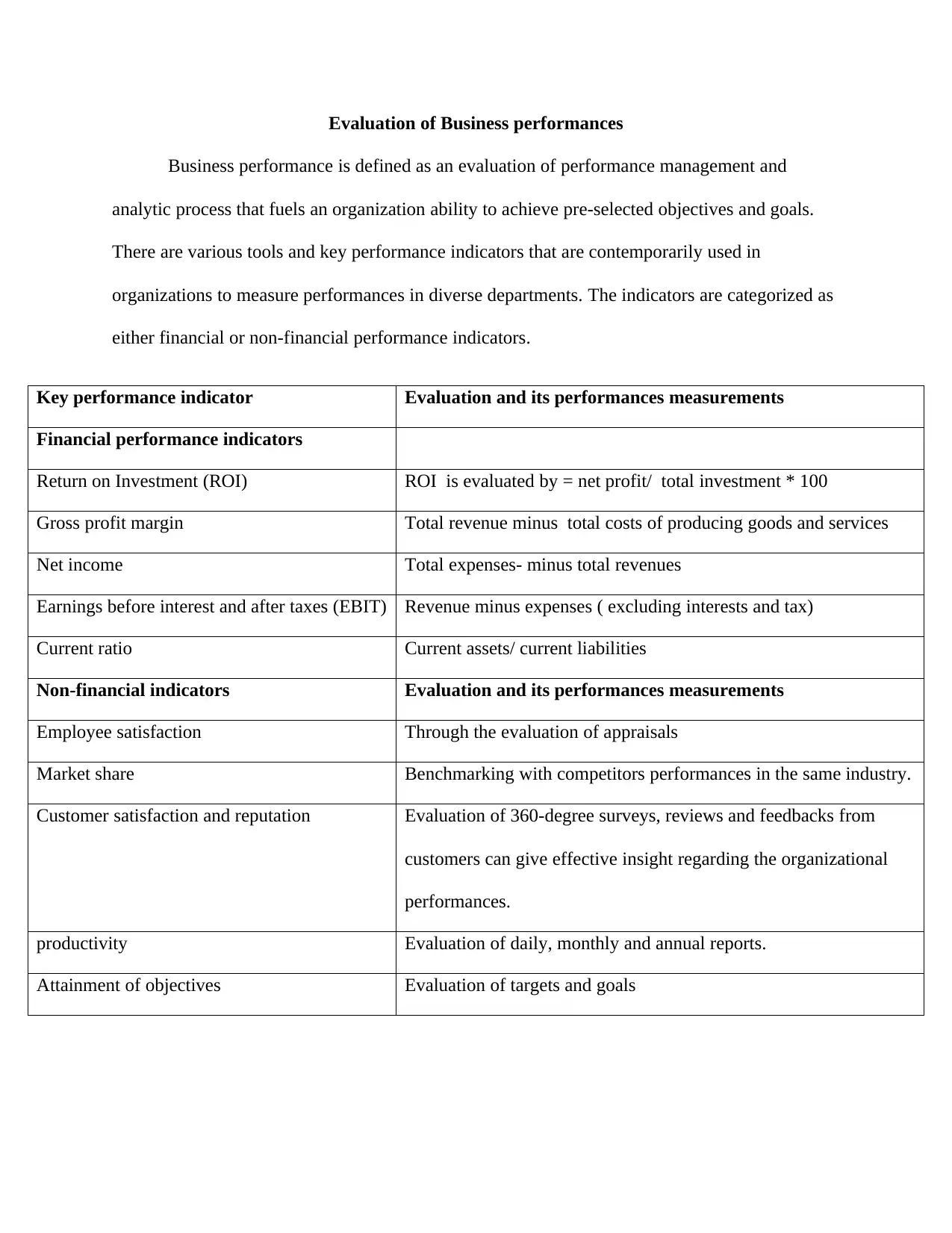
Evaluation of Business performances
Business performance is defined as an evaluation of performance management and
analytic process that fuels an organization ability to achieve pre-selected objectives and goals.
There are various tools and key performance indicators that are contemporarily used in
organizations to measure performances in diverse departments. The indicators are categorized as
either financial or non-financial performance indicators.
Key performance indicator Evaluation and its performances measurements
Financial performance indicators
Return on Investment (ROI) ROI is evaluated by = net profit/ total investment * 100
Gross profit margin Total revenue minus total costs of producing goods and services
Net income Total expenses- minus total revenues
Earnings before interest and after taxes (EBIT) Revenue minus expenses ( excluding interests and tax)
Current ratio Current assets/ current liabilities
Non-financial indicators Evaluation and its performances measurements
Employee satisfaction Through the evaluation of appraisals
Market share Benchmarking with competitors performances in the same industry.
Customer satisfaction and reputation Evaluation of 360-degree surveys, reviews and feedbacks from
customers can give effective insight regarding the organizational
performances.
productivity Evaluation of daily, monthly and annual reports.
Attainment of objectives Evaluation of targets and goals
Business performance is defined as an evaluation of performance management and
analytic process that fuels an organization ability to achieve pre-selected objectives and goals.
There are various tools and key performance indicators that are contemporarily used in
organizations to measure performances in diverse departments. The indicators are categorized as
either financial or non-financial performance indicators.
Key performance indicator Evaluation and its performances measurements
Financial performance indicators
Return on Investment (ROI) ROI is evaluated by = net profit/ total investment * 100
Gross profit margin Total revenue minus total costs of producing goods and services
Net income Total expenses- minus total revenues
Earnings before interest and after taxes (EBIT) Revenue minus expenses ( excluding interests and tax)
Current ratio Current assets/ current liabilities
Non-financial indicators Evaluation and its performances measurements
Employee satisfaction Through the evaluation of appraisals
Market share Benchmarking with competitors performances in the same industry.
Customer satisfaction and reputation Evaluation of 360-degree surveys, reviews and feedbacks from
customers can give effective insight regarding the organizational
performances.
productivity Evaluation of daily, monthly and annual reports.
Attainment of objectives Evaluation of targets and goals
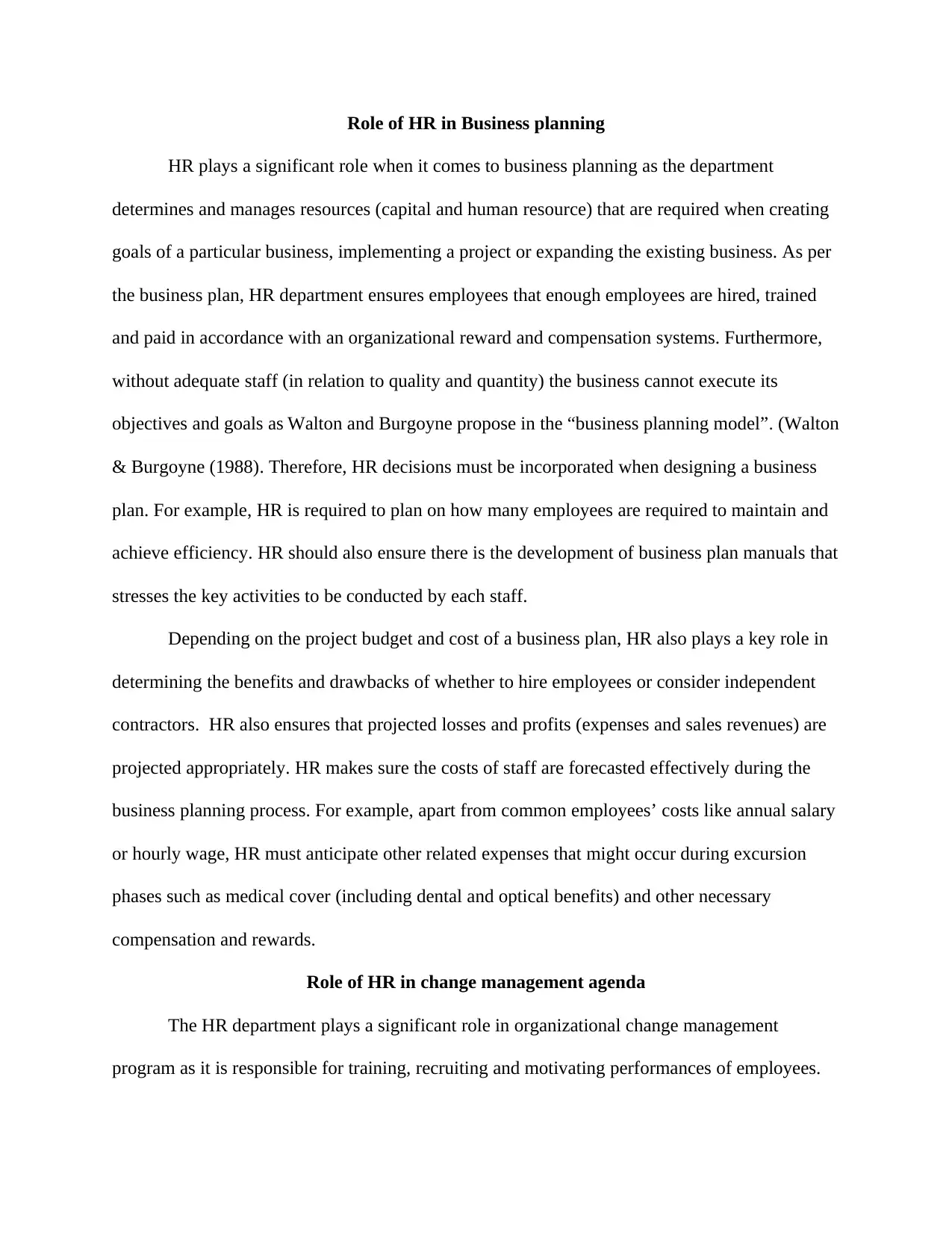
Role of HR in Business planning
HR plays a significant role when it comes to business planning as the department
determines and manages resources (capital and human resource) that are required when creating
goals of a particular business, implementing a project or expanding the existing business. As per
the business plan, HR department ensures employees that enough employees are hired, trained
and paid in accordance with an organizational reward and compensation systems. Furthermore,
without adequate staff (in relation to quality and quantity) the business cannot execute its
objectives and goals as Walton and Burgoyne propose in the “business planning model”. (Walton
& Burgoyne (1988). Therefore, HR decisions must be incorporated when designing a business
plan. For example, HR is required to plan on how many employees are required to maintain and
achieve efficiency. HR should also ensure there is the development of business plan manuals that
stresses the key activities to be conducted by each staff.
Depending on the project budget and cost of a business plan, HR also plays a key role in
determining the benefits and drawbacks of whether to hire employees or consider independent
contractors. HR also ensures that projected losses and profits (expenses and sales revenues) are
projected appropriately. HR makes sure the costs of staff are forecasted effectively during the
business planning process. For example, apart from common employees’ costs like annual salary
or hourly wage, HR must anticipate other related expenses that might occur during excursion
phases such as medical cover (including dental and optical benefits) and other necessary
compensation and rewards.
Role of HR in change management agenda
The HR department plays a significant role in organizational change management
program as it is responsible for training, recruiting and motivating performances of employees.
HR plays a significant role when it comes to business planning as the department
determines and manages resources (capital and human resource) that are required when creating
goals of a particular business, implementing a project or expanding the existing business. As per
the business plan, HR department ensures employees that enough employees are hired, trained
and paid in accordance with an organizational reward and compensation systems. Furthermore,
without adequate staff (in relation to quality and quantity) the business cannot execute its
objectives and goals as Walton and Burgoyne propose in the “business planning model”. (Walton
& Burgoyne (1988). Therefore, HR decisions must be incorporated when designing a business
plan. For example, HR is required to plan on how many employees are required to maintain and
achieve efficiency. HR should also ensure there is the development of business plan manuals that
stresses the key activities to be conducted by each staff.
Depending on the project budget and cost of a business plan, HR also plays a key role in
determining the benefits and drawbacks of whether to hire employees or consider independent
contractors. HR also ensures that projected losses and profits (expenses and sales revenues) are
projected appropriately. HR makes sure the costs of staff are forecasted effectively during the
business planning process. For example, apart from common employees’ costs like annual salary
or hourly wage, HR must anticipate other related expenses that might occur during excursion
phases such as medical cover (including dental and optical benefits) and other necessary
compensation and rewards.
Role of HR in change management agenda
The HR department plays a significant role in organizational change management
program as it is responsible for training, recruiting and motivating performances of employees.
⊘ This is a preview!⊘
Do you want full access?
Subscribe today to unlock all pages.

Trusted by 1+ million students worldwide
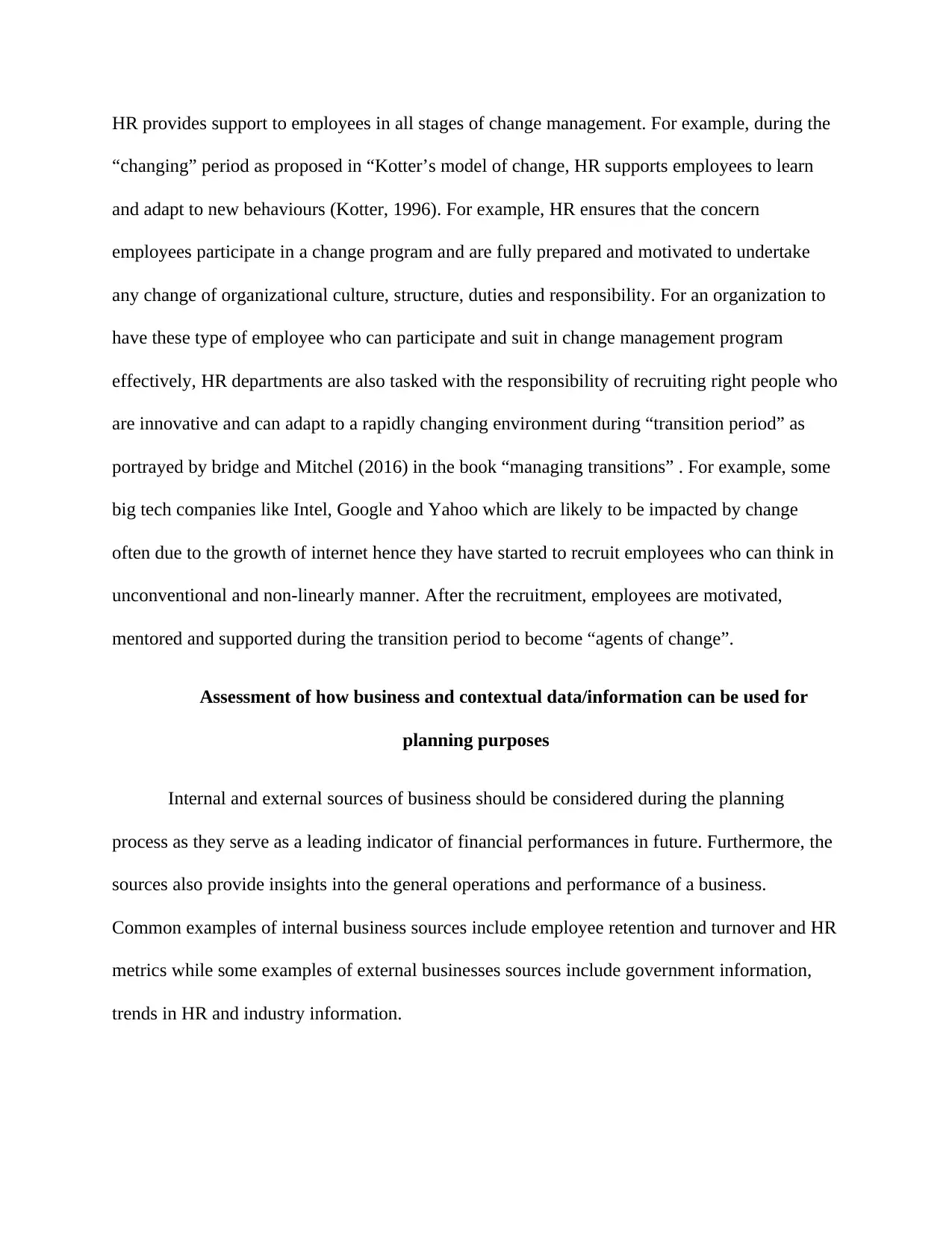
HR provides support to employees in all stages of change management. For example, during the
“changing” period as proposed in “Kotter’s model of change, HR supports employees to learn
and adapt to new behaviours (Kotter, 1996). For example, HR ensures that the concern
employees participate in a change program and are fully prepared and motivated to undertake
any change of organizational culture, structure, duties and responsibility. For an organization to
have these type of employee who can participate and suit in change management program
effectively, HR departments are also tasked with the responsibility of recruiting right people who
are innovative and can adapt to a rapidly changing environment during “transition period” as
portrayed by bridge and Mitchel (2016) in the book “managing transitions” . For example, some
big tech companies like Intel, Google and Yahoo which are likely to be impacted by change
often due to the growth of internet hence they have started to recruit employees who can think in
unconventional and non-linearly manner. After the recruitment, employees are motivated,
mentored and supported during the transition period to become “agents of change”.
Assessment of how business and contextual data/information can be used for
planning purposes
Internal and external sources of business should be considered during the planning
process as they serve as a leading indicator of financial performances in future. Furthermore, the
sources also provide insights into the general operations and performance of a business.
Common examples of internal business sources include employee retention and turnover and HR
metrics while some examples of external businesses sources include government information,
trends in HR and industry information.
“changing” period as proposed in “Kotter’s model of change, HR supports employees to learn
and adapt to new behaviours (Kotter, 1996). For example, HR ensures that the concern
employees participate in a change program and are fully prepared and motivated to undertake
any change of organizational culture, structure, duties and responsibility. For an organization to
have these type of employee who can participate and suit in change management program
effectively, HR departments are also tasked with the responsibility of recruiting right people who
are innovative and can adapt to a rapidly changing environment during “transition period” as
portrayed by bridge and Mitchel (2016) in the book “managing transitions” . For example, some
big tech companies like Intel, Google and Yahoo which are likely to be impacted by change
often due to the growth of internet hence they have started to recruit employees who can think in
unconventional and non-linearly manner. After the recruitment, employees are motivated,
mentored and supported during the transition period to become “agents of change”.
Assessment of how business and contextual data/information can be used for
planning purposes
Internal and external sources of business should be considered during the planning
process as they serve as a leading indicator of financial performances in future. Furthermore, the
sources also provide insights into the general operations and performance of a business.
Common examples of internal business sources include employee retention and turnover and HR
metrics while some examples of external businesses sources include government information,
trends in HR and industry information.
Paraphrase This Document
Need a fresh take? Get an instant paraphrase of this document with our AI Paraphraser
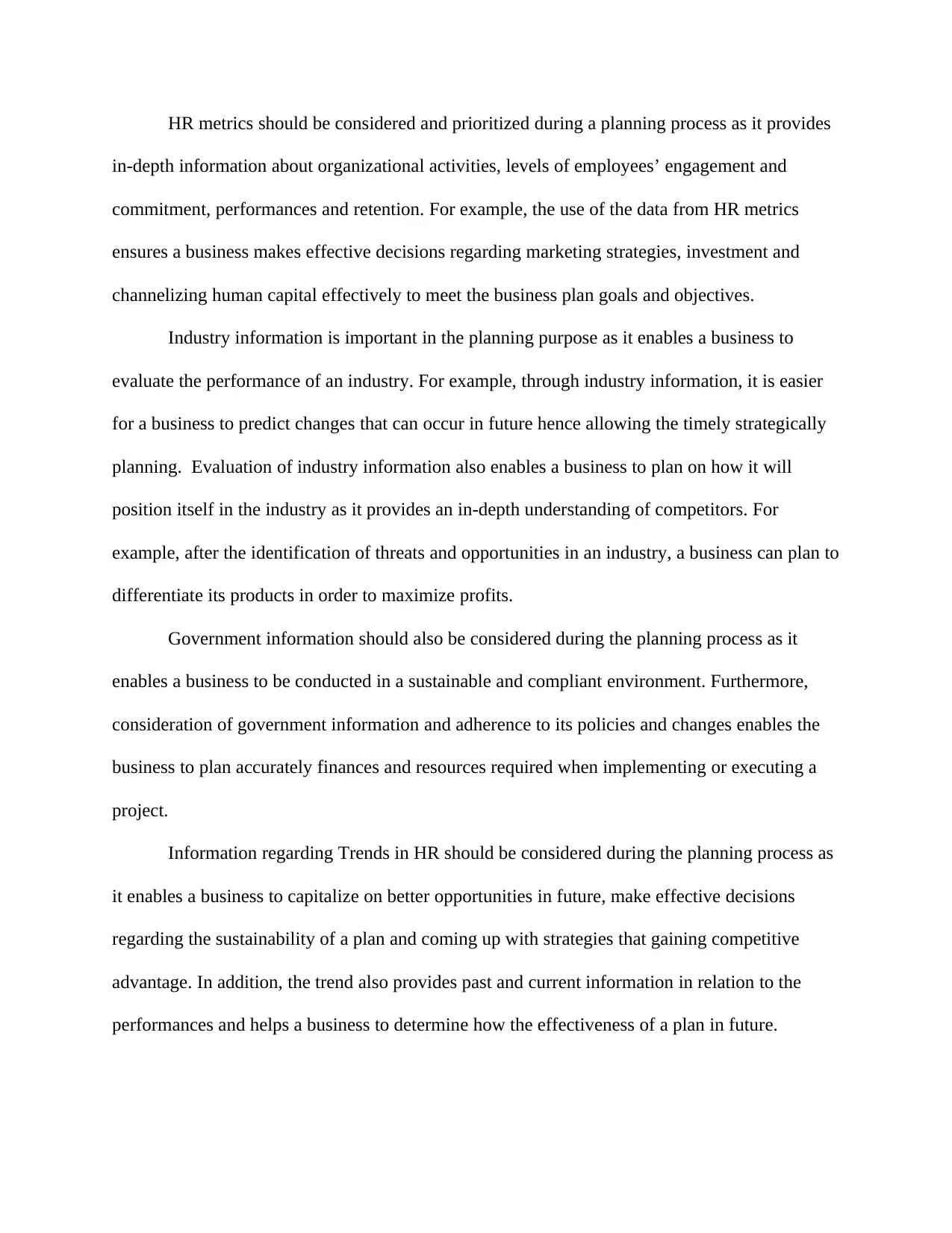
HR metrics should be considered and prioritized during a planning process as it provides
in-depth information about organizational activities, levels of employees’ engagement and
commitment, performances and retention. For example, the use of the data from HR metrics
ensures a business makes effective decisions regarding marketing strategies, investment and
channelizing human capital effectively to meet the business plan goals and objectives.
Industry information is important in the planning purpose as it enables a business to
evaluate the performance of an industry. For example, through industry information, it is easier
for a business to predict changes that can occur in future hence allowing the timely strategically
planning. Evaluation of industry information also enables a business to plan on how it will
position itself in the industry as it provides an in-depth understanding of competitors. For
example, after the identification of threats and opportunities in an industry, a business can plan to
differentiate its products in order to maximize profits.
Government information should also be considered during the planning process as it
enables a business to be conducted in a sustainable and compliant environment. Furthermore,
consideration of government information and adherence to its policies and changes enables the
business to plan accurately finances and resources required when implementing or executing a
project.
Information regarding Trends in HR should be considered during the planning process as
it enables a business to capitalize on better opportunities in future, make effective decisions
regarding the sustainability of a plan and coming up with strategies that gaining competitive
advantage. In addition, the trend also provides past and current information in relation to the
performances and helps a business to determine how the effectiveness of a plan in future.
in-depth information about organizational activities, levels of employees’ engagement and
commitment, performances and retention. For example, the use of the data from HR metrics
ensures a business makes effective decisions regarding marketing strategies, investment and
channelizing human capital effectively to meet the business plan goals and objectives.
Industry information is important in the planning purpose as it enables a business to
evaluate the performance of an industry. For example, through industry information, it is easier
for a business to predict changes that can occur in future hence allowing the timely strategically
planning. Evaluation of industry information also enables a business to plan on how it will
position itself in the industry as it provides an in-depth understanding of competitors. For
example, after the identification of threats and opportunities in an industry, a business can plan to
differentiate its products in order to maximize profits.
Government information should also be considered during the planning process as it
enables a business to be conducted in a sustainable and compliant environment. Furthermore,
consideration of government information and adherence to its policies and changes enables the
business to plan accurately finances and resources required when implementing or executing a
project.
Information regarding Trends in HR should be considered during the planning process as
it enables a business to capitalize on better opportunities in future, make effective decisions
regarding the sustainability of a plan and coming up with strategies that gaining competitive
advantage. In addition, the trend also provides past and current information in relation to the
performances and helps a business to determine how the effectiveness of a plan in future.
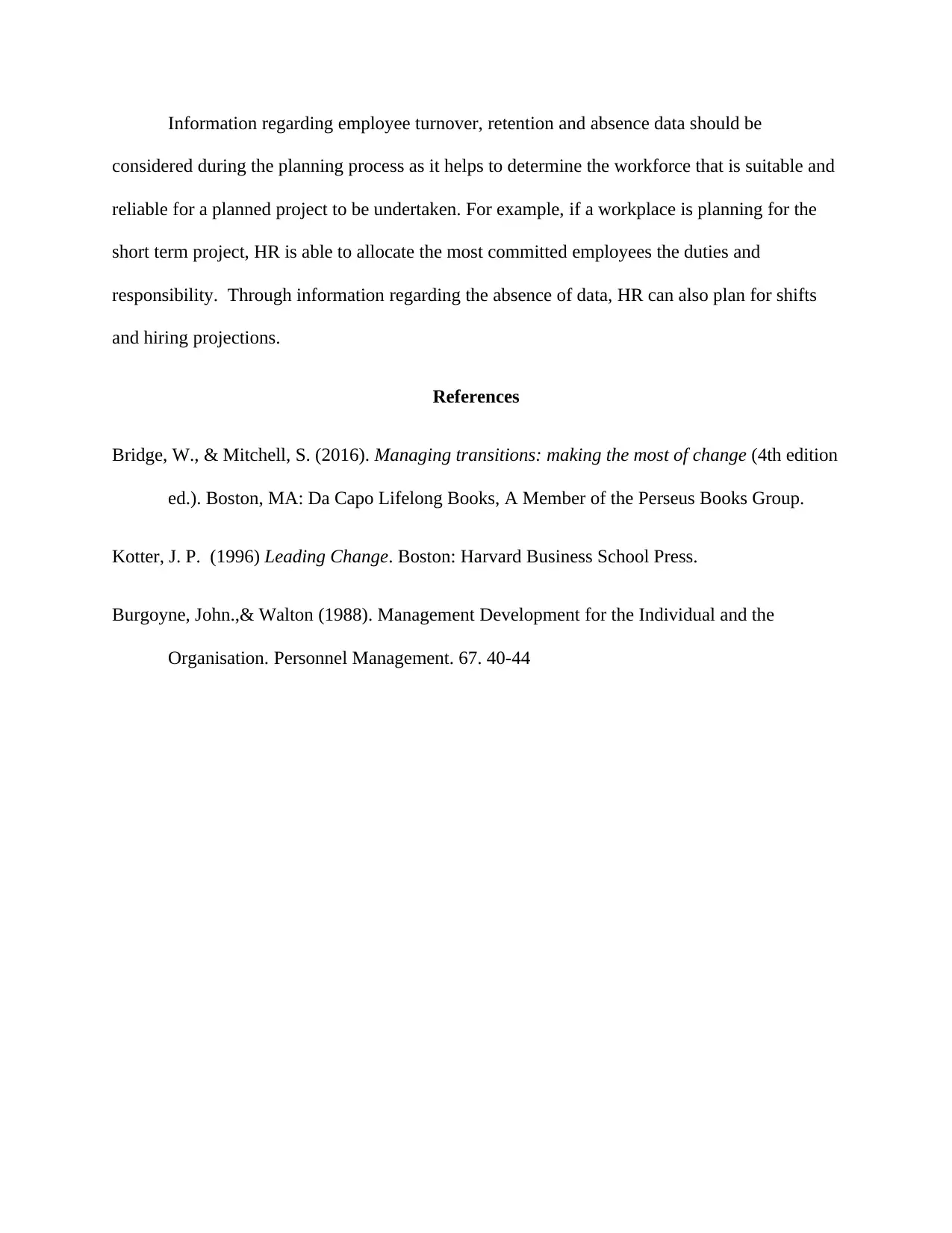
Information regarding employee turnover, retention and absence data should be
considered during the planning process as it helps to determine the workforce that is suitable and
reliable for a planned project to be undertaken. For example, if a workplace is planning for the
short term project, HR is able to allocate the most committed employees the duties and
responsibility. Through information regarding the absence of data, HR can also plan for shifts
and hiring projections.
References
Bridge, W., & Mitchell, S. (2016). Managing transitions: making the most of change (4th edition
ed.). Boston, MA: Da Capo Lifelong Books, A Member of the Perseus Books Group.
Kotter, J. P. (1996) Leading Change. Boston: Harvard Business School Press.
Burgoyne, John.,& Walton (1988). Management Development for the Individual and the
Organisation. Personnel Management. 67. 40-44
considered during the planning process as it helps to determine the workforce that is suitable and
reliable for a planned project to be undertaken. For example, if a workplace is planning for the
short term project, HR is able to allocate the most committed employees the duties and
responsibility. Through information regarding the absence of data, HR can also plan for shifts
and hiring projections.
References
Bridge, W., & Mitchell, S. (2016). Managing transitions: making the most of change (4th edition
ed.). Boston, MA: Da Capo Lifelong Books, A Member of the Perseus Books Group.
Kotter, J. P. (1996) Leading Change. Boston: Harvard Business School Press.
Burgoyne, John.,& Walton (1988). Management Development for the Individual and the
Organisation. Personnel Management. 67. 40-44
⊘ This is a preview!⊘
Do you want full access?
Subscribe today to unlock all pages.

Trusted by 1+ million students worldwide
1 out of 6
Related Documents
Your All-in-One AI-Powered Toolkit for Academic Success.
+13062052269
info@desklib.com
Available 24*7 on WhatsApp / Email
![[object Object]](/_next/static/media/star-bottom.7253800d.svg)
Unlock your academic potential
Copyright © 2020–2025 A2Z Services. All Rights Reserved. Developed and managed by ZUCOL.




